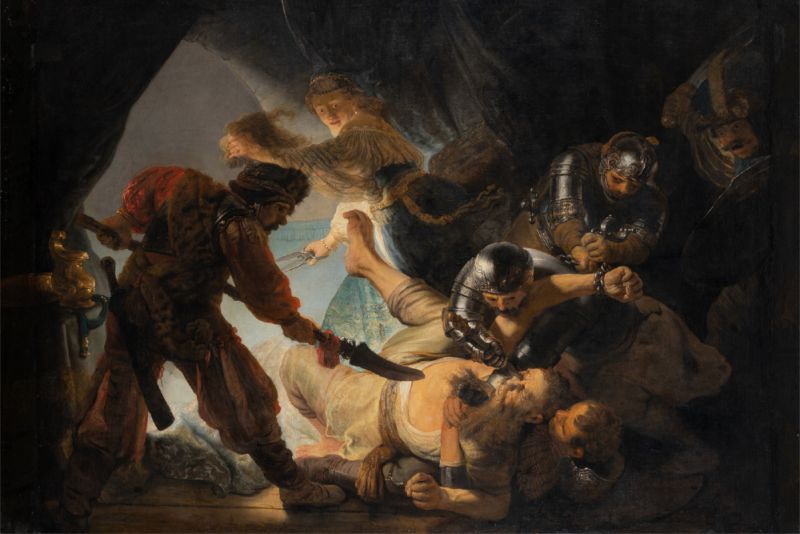Queen’s professor co-curates National Gallery of Canada’s first major Rembrandt exhibition
The National Gallery of Canada (NGC) will soon present its first-ever exhibition of masterpieces by the world-renowned artist Rembrandt van Rijn, marking the country’s first major loan exhibition focused on Rembrandt since 1969. Co-curated by Queen’s Professor Stephanie Dickey, Rembrandt in Amsterdam: Creativity and Competition charts the central decades of the artist's career within the context of the thriving Amsterdam art market, bringing Rembrandt’s art into context alongside works by other artists who were his friends, followers, and rivals in Amsterdam.

Rembrandt van Rijn's painting The Blinding of Samson, created in 1636. (Photo provided by: Städel Museum, Frankfurt am Main)
“I am really excited to introduce Canadian viewers to remarkable artworks that have never been shown here before,” says Dr. Dickey, the Bader Chair in Northern Baroque Art. “This exhibition picks up perfectly from Leiden circa 1630: Rembrandt Emerges, which debuted at Queen’s Agnes Etherington Art Centre in 2019. The Agnes show, curated by Jacquelyn N. Coutré, former Bader Curator and Researcher of European Art, examined Rembrandt’s early years as an emerging artist in his hometown of Leiden. In 1632, he made the decision to move to Amsterdam, a larger city that was fast becoming the commercial and cultural capital of Northern Europe. The National Gallery exhibition explores how Amsterdam’s stimulating creative environment inspired Rembrandt to reach his full potential as an artist, teacher, and entrepreneur.”
Thirty lenders from across Canada, the U.S., and Europe have contributed to the works on display. Three paintings from Agnes Etherington Art Centre’s Bader Collection – one each by Rembrandt and his associates Govert Flinck and Nicolaes Maes – will join the installation, which features 21 paintings, eight drawings, and dozens of prints by Rembrandt and works by 20 of his contemporaries.
Notably, the exhibition also integrates newly-commissioned and acquired works by contemporary Indigenous and Black artists based in Canada that reflect on the impact of colonialism in Rembrandt’s time and beyond.
“Exhibiting European art of the colonial period is something we can no longer take for granted,” Dr. Dickey says. “The global trade empire that fueled Dutch – and European – prosperity was part of a culture of colonialism that created much suffering, including the exploitation and enslavement of Indigenous peoples in Africa, Indonesia, and North America. We have added new dimensions to this show by including contributions by Black and Indigenous scholars and contemporary artists, and we hope to present one of only 11 preserved examples of the Two-Row Wampum, a sacred Indigenous record of the first treaty between the Haudenosaunee people and Dutch settlers.”
The treaty marks the first diplomatic contact between Dutch settlers and Indigenous peoples in the area around what is now Albany, New York. It dates to 1613, during Rembrandt’s lifetime, creating a powerful link that prompts reflection on the role of North America within the global story of European colonialism.
A major exhibition like this one takes several years to come together. Dr. Dickey was involved at all stages of the project, from researching and selecting the works to be featured, to contributing to and co-editing the exhibit’s accompanying catalogue. She also worked together with the NGC and Städel teams on exhibit design, programming, and marketing.
“The theme for this exhibition grew out of my own research and teaching here at Queen’s, and I am delighted that it captured the interest of my colleagues at the National Gallery and the Städel,” Dr. Dickey says. “A major museum project like this involves a lot of people and an extraordinary level of teamwork that is quite different from my usual, rather solitary, life as a scholar. It has been an exciting process that gives me great respect for the complicated work done by museum professionals.”
While Dr. Dickey is an internationally-recognized expert in Dutch art, she is also a professor deeply committed to sharing her passion for the history of visual culture with Queen’s students.
“Students in Canada rarely have a chance to learn in such close proximity to major masterworks from the European historical tradition, so exhibitions like this, and the work leading up to them, provide unique opportunities for our students to engage with important artworks,” says Norman Vorano, Head of Queen’s Department of Art History and Art Conservation. “Professor Dickey is not only an internationally-recognized expert, but she has a wonderful gift in being able to connect with students and to make these 400-year-old paintings ‘relatable’ and relevant to new and diverse audiences. I want to congratulate her and the National Gallery of Canada.”
During the years spent developing the exhibit, many of Dr. Dickey’s students assisted with research that informed its creation through class assignments and independent projects.
“There are many ways to approach art history, from theory and cultural context to technical examination, and putting together a museum exhibition requires developing all of those skills,” Dr. Dickey says. “Most of all, a project like this one, with broad public appeal, shows students the real-world applications of what we do.”
Organized by the National Gallery of Canada and the Städel Museum in Frankfurt, Germany, Rembrandt in Amsterdam: Creativity and Competition is scheduled to run in Ottawa from mid-May to Sept. 6, 2021. The original opening date of May 14 has been delayed by Ontario’s current public health guidelines in response to COVID-19. A new opening date will be announced as soon as it is available.
For more information on the exhibition, related public programs, and on-line resources, visit the National Gallery of Canada website.
The story was originally published in the Gazette.

